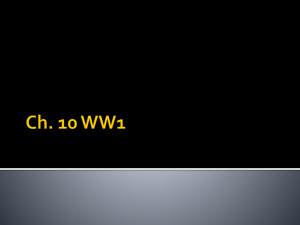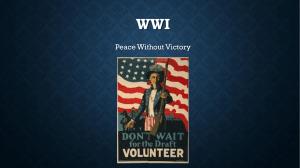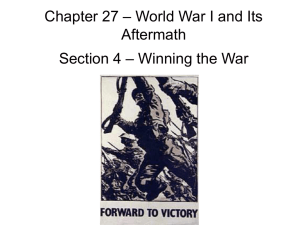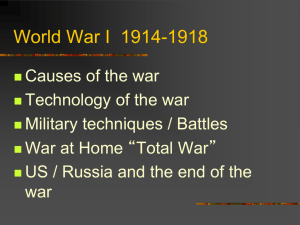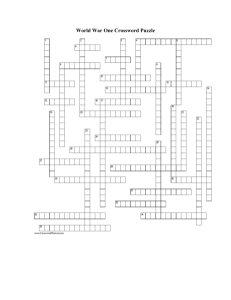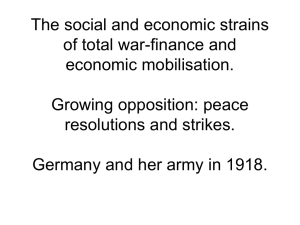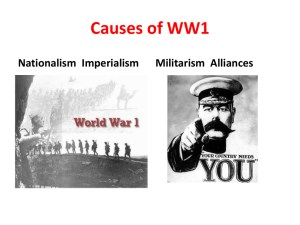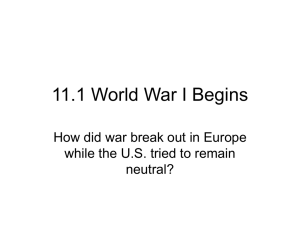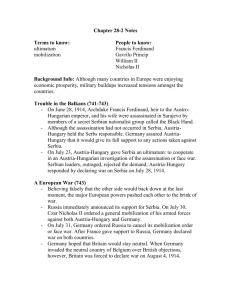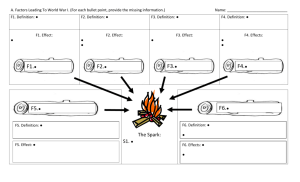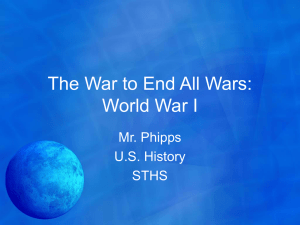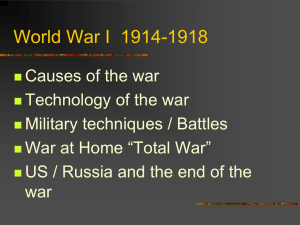World War 1
advertisement
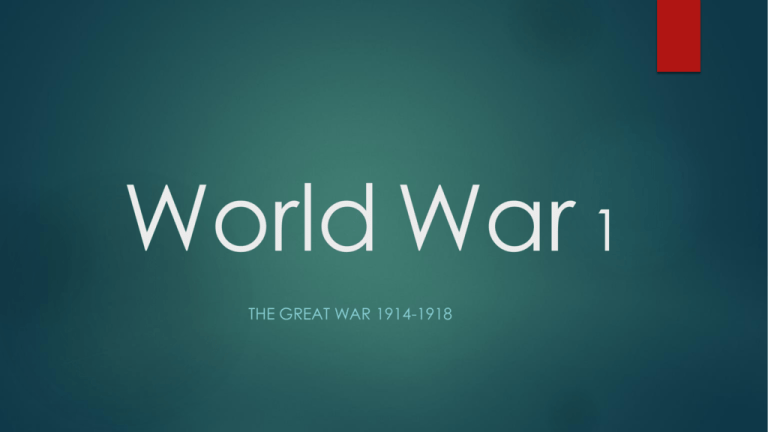
World War 1 THE GREAT WAR 1914-1918 The Great War: World War I The War to End All Wars “THE LAMPS HAVE GONE OUT ALL OVER EUROPE AND WE SHALL NOT SEE THEM LIT AGAIN IN OUR LIFETIME.” - BRITISH PRIME MINISTER LORD GREY Traditional European Rules of War 1. A country must declare war before attacking another country. 2. Each side must wear uniforms or identify themselves to each other before attacking. Soldiers wearing an enemy uniform will be shot as a spy. 3. Commanding officers should not be targeted 4. Civilians, Surrendering Soldiers and Medical Personnel will not be attacked. 5. Hand to Hand combat is honorable, shooting from a distance is cowardly 6. Soldiers must be given the opportunity to surrender honorably. Europe Before World War I Long Term Causes of World War I • • • • • Nationalism Militarism Imperialism Peace time alliances Long-standing ethnic grudges Short term timeline leading to World War I June 28 - Assassination of Austro-Hungarian Archduke and heir, Francis Ferdinand (and Sophie, his wife) July 23 - Austria issues ultimatum to Serbia and invades on July 27 July 28-30 - Russians mobilize as Serbia’s ally August 1 - Germany, Austria-Hungary’s ally, declares war on Russia (and Serbia) August 3 - Germany declares war on France (allied with Russia) and invades Belgium en route to Paris, France August 4 - Great Britain, France’s ally, declares war on Germany The Assassination of Archduke Franz Ferndinand 28th June 1914 Archduke Franz Ferdinand of Austria-Hungary, far right, was shot to death on June 28, 1914, shortly after this photo was taken. His assassination triggered the outbreak of World War I. Gavrilo Pricip assassinated Archduke Franz Ferdinand, He was a student at this time Who's to blame The sides formed Triple Entente (Allies) France Great Britain Italy Russia (1917 exit) United States (1917 entry) Central Powers Germany Austria-Hungary (empire) Ottoman Empire Bulgaria Summer of 1914 Triple Entente/Triple Alliance Actions July 23rd Austria Hungary Presents Serbia with an ultimatum July 28th Austria-Hungary declares war on Serbia July 29th Russia Mobilizes its troops August 1, 1914 Germany mobilizes troops. August 2nd Germany declares war on Russia Germany invades Poland and Luxemburg, invasion of France starts August 3: Germany declares war on France August 4: Germany declares war on Belgium and invades it, August 4:England declares war on Germany August 5: Austria declares war on Russia and Great Britain Europe 1914 By the end of 1914, not only Europe was at war, but also all of Europe’s colonies in Asia, Africa and South America. The German plan against France was to rush into the country as fast as possible: The Schlieffen Plan The Machine Gun stopped this plan Trench Warfare Both sides dug long trenches that faced each other. The trenches ran for miles. From time to time, one side would attempt to cross the “No-Man’s Land” the area in between the trenches. Trench warfare made WWI extend from a few months of fighting to four years of fighting Technology: Chemical Weapons • WWI was the first major war to use chemical weapons • Mustard Gas and Chlorine Gas were the two most popular weapons: They caused suffocation, blindness, and death The U-boat (Submarine) Germany’s secret weapon during the war Sank dozens of British ships, controlled the oceans. Air Power Both sides used aircraft for observation, limited bombing, and air battles Airplanes were slow, clumsy, and unreliable, The most famous German pilot was Baron von Richthofen (The Red Baron) Tanks and Flamethrowers The Great War Western Front Germans, Austria-Hungarians vs. French, British and later Americans Germany develops the Schlieffen Plan Battle of the Marne (1914- German Defeat) Trench Warfare on the Western Front Great Battles of the Western Front Battle of Verdun Ten months long French and German armies. Estimated 540,000 French and 430,000 German casualties No strategic advantages were gained for either side. Battle of Somme English and French vs Germany Six months of fighting Five miles of advancement for Allies 1 million men killed The Eastern Front Russians and Serbs vs. Germans and Austria-Hungarians War more mobile but still a stalemate Russia’s disadvantages Not Industrialized Short on Supplies Russia’s advantage People The Eastern Front – Battles Battle of Tannenberg: August 1914- First major eastern battle. Russia was badly defeated and pushed back. Russia lost millions of men against Germany, undersupplied, under gunned Other Fronts Japan, Australia, India join Allies Ottoman Turks, Bulgaria join Central Powers Gallipoli Campaign in the Ottoman Empire Battles occur in Africa and Asia for Colonial Possessions Russia Exits the War In March 1917, Nicholas II abdicates his throne, the Russian Duma continues to fight. In October 1917: Lenin and the Bolsheviks take command: The Soviet Union is created. March 1918: Soviets and Germans sign the Treaty of Brest-Litovsk, ending the war in the East. U.S road to War May 7th 1915 Sinking of the Lusitania US Declares War Senate Declares War April 4th 1917 House of Representatives Declares War April 6th 1917 Wilson’s reasoning for War make the world “Safe for Democracy” Propaganda British Army German Army Ending the War US Enters the War in April of 1917 March 1918 Russia and Germany sign the Treaty of Brest-Litovsk Germans now use all resources on Western Front March of 1918 Germany begins a massive attack on France The Tide Turns German troops fatigued US had 140,000 “fresh” troops 2nd Battle of the Marne (June 1918) Central Powers Crumble Revolutions in Austria Hungary Ottoman Empire surrenders German soldiers mutiny, public turns against Kaiser Wilhelm II Ending the War (1918) Kaiser Wilhelm abdicates on November 9th 1918 11th hour of the 11th day of the 11th month in 1918 Germany agrees to a cease-fire 8.5 million soldiers dead 21 million soldiers wounded Cost of 338 billion dollars Ending the War The Paris Peace Conference Meeting of the “Big Four” at the Paris Peace Conference Wilson Proposes his “14 points” “Big Four” create Treaty of Versailles War Guilt Clause Break up of German, Austrian, Russian and Ottoman Empire Reparations Legacy of bitterness and betrayal Effects of World War I Before World War I feeling of optimism and progress of Human Kind After the War feelings of pessimism New forms of Art, Literature, Philosophy and Science Approximate Comparative Losses in World War I
